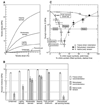The transition from stiff to compliant materials in squid beaks
- PMID: 18369144
- PMCID: PMC2754134
- DOI: 10.1126/science.1154117
The transition from stiff to compliant materials in squid beaks
Abstract
The beak of the Humboldt squid Dosidicus gigas represents one of the hardest and stiffest wholly organic materials known. As it is deeply embedded within the soft buccal envelope, the manner in which impact forces are transmitted between beak and envelope is a matter of considerable scientific interest. Here, we show that the hydrated beak exhibits a large stiffness gradient, spanning two orders of magnitude from the tip to the base. This gradient is correlated with a chemical gradient involving mixtures of chitin, water, and His-rich proteins that contain 3,4-dihydroxyphenyl-L-alanine (dopa) and undergo extensive stabilization by histidyl-dopa cross-link formation. These findings may serve as a foundation for identifying design principles for attaching mechanically mismatched materials in engineering and biological applications.
Figures




Comment in
-
Materials science. Multitasking in tissues and materials.Science. 2008 Mar 28;319(5871):1767-8. doi: 10.1126/science.1155122. Science. 2008. PMID: 18369126 No abstract available.
References
Publication types
MeSH terms
Substances
Grants and funding
LinkOut - more resources
Full Text Sources
Other Literature Sources
Research Materials

